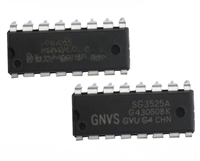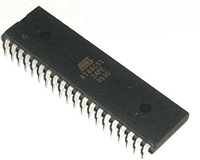AD8131
In this case, the input signal is provided by a signal generator
with an output impedance of 50 Ω. This is terminated with a
49.9 Ω resistor near +DIN of the AD8131. The effective parallel
resistance of the source and termination is 25 Ω. The 24.9 Ω
resistor from –DIN to ground matches the +DIN source impedance
and minimizes any dc and gain errors.
RG
RF
RIN ,dm
=
= 1.125 kΩ
1 −
2 × RG + RF
(
)
If +DIN is driven by a low-impedance source over a short dis-
tance, such as the output of an op amp, then no termination
resistor is required at +DIN. In this case, the –DIN can be
directly tied to ground.
The circuit’s input impedance is effectively higher than it would
be for a conventional op amp connected as an inverter because
a fraction of the differential output voltage appears at the inputs
as a common-mode signal, partially bootstrapping the voltage
across the input resistor RG.
+3 V Supply Differential A-to-D Driver
Many newer A-to-D converters can run from a single +3 V
supply, which can save significant system power. In order to
increase the dynamic range at the analog input, they have differ-
ential inputs, which doubles the dynamic range with respect to a
single-ended input. An added benefit of using a differential
input is that the distortion can be improved.
Input Common-Mode Voltage Range in Single Supply
Applications
The AD8131 is optimized for level-shifting “ground” referenced
input signals. For a single-ended input this would imply, for
example, that the voltage at –DIN in Figure 37 would be zero
volts when the amplifier’s negative power supply voltage (at V–)
was also set to zero volts.
The low distortion and ability to run from a single +3 V supply
make the AD8131 suited as an A-to-D driver for some 10-bit,
single supply applications. Figure 39 shows a schematic for a
circuit for an AD8131 driving an AD9203, a 10-bit, 40 MSPS
A-to-D converter.
Setting the Output Common-Mode Voltage
The AD8131’s VOCM pin is internally biased at a voltage
approximately equal to the midsupply point (average value of
the voltages on V+ and V–). Relying on this internal bias will
result in an output common-mode voltage that is within about
25 mV of the expected value.
The common mode of the AD8131 output is set at midsupply
by the voltage divider connected to VOCM, and ac bypassed with
a 0.1 µF capacitor. This provides for maximum dynamic range
between the supplies at the output of the AD8131. The 110 Ω
resistors at the AD8131 output, along with the shunt capacitors
form a one pole, low-pass filter for lowering noise and antialiasing.
In cases where more accurate control of the output common-
mode level is required, it is recommended that an external
source, or resistor divider (made up of 10 kΩ resistors), be used.
Driving a Capacitive Load
Figure 40 shows an FFT plot that was taken from the combined
devices at an analog input frequency of 2.5 MHz and a 40 MSPS
sampling rate. The performance of the AD8131 compares very
favorably with a center-tapped transformer drive, which has
typically been the best way to drive this A-to-D converter. The
AD8131 has the advantage of maintaining dc performance,
which a transformer solution cannot provide.
A purely capacitive load can react with the pin and bondwire
inductance of the AD8131 resulting in high frequency ringing in
the pulse response. One way to minimize this effect is to place a
small resistor in series with the amplifier’s outputs as shown in
Figure 23.
APPLICATIONS
Unity-Gain, Single-Ended-to-Differential Driver
If it is not necessary to offset the output common-mode volt-
age (via the VOCM pin), then the AD8131 can make a simple
unity-gain single-ended-to-differential amplifier that does not
require any external components. Figure 41 shows the schematic
for this circuit.
Twisted-Pair Line Driver
The AD8131 has on-chip resistors that provide for a gain-of-
two without any external parts. Several on-chip resistors are
trimmed to ensure that the gain is accurate, the common-mode
rejection is good, and the output is well balanced. This makes
the AD8131 very suitable as a single-ended-to-differential
twisted-pair line driver.
Referring to Figure 2, when –DIN is left floating, there is 100
percent feedback of +OUT to –IN via the internal feedback
resistor. This contrasts with the typical gain-of-two operation
where –DIN is grounded and one third of the +OUT is fed back
to –IN. The result is a closed-loop differential gain of one.
Figure 38 shows a circuit of an AD8131 driving a twisted-pair
line, like a Category 3 or Category 5 (Cat3 or Cat5), that are
already installed in many buildings for telephony and data com-
munications. The characteristic impedance of such transmission
lines is usually about 100 Ω. The outstanding balance of the
AD8131 output will minimize the common-mode signal and there-
fore the amount of EMI generated by driving the twisted pair.
Upon careful observation, it can be seen that only +DIN and
VOCM are referenced to ground. It is the case that the ground
voltage at VOCM is the reference for this circuit. In this unity
gain configuration, if a dc voltage is applied to VOCM to shift the
common-mode voltage, a differential dc voltage will be created
at the output, along with the common-mode voltage change.
Thus, this configuration cannot be used when it is desired to
offset the common-mode voltage of the output with respect to
the input at +DIN.
The two resistors in series with each output terminate the line at
the transmit end. Since the impedances of the outputs of the
AD8131 are very low, they can be thought of as a short circuit,
and the two terminating resistors form a 100 Ω termination at
the transmit end of the transmission line. The receive end is
directly terminated by a 100 Ω resistor across the line.
This back-termination of the transmission line divides the out-
put signal by two. The fixed gain of two of the AD8131 will
create a net unity gain for the system from end to end.
REV. 0
–10–






 SG3525资料手册详解:SG3525参数分析、引脚说明、应用介绍
SG3525资料手册详解:SG3525参数分析、引脚说明、应用介绍

 AT89C51单片机资料手册详细解析及应用示例
AT89C51单片机资料手册详细解析及应用示例

 CP2102资料手册解读:CP2102引脚说明、关键参数分析
CP2102资料手册解读:CP2102引脚说明、关键参数分析

 资料手册解读:UC3842参数和管脚说明
资料手册解读:UC3842参数和管脚说明
